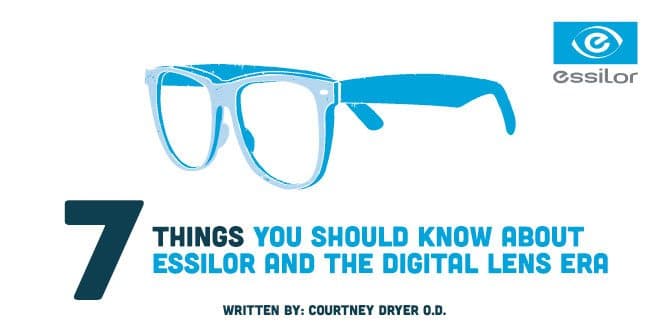This is a sponsored post by Essilor of America, a supporter of CovalentCareers & new graduate optometrists!
In order to best prescribe specific lenses for your patient, and explain the difference in progressive lens quality, it is imperative that you as the doctor understand digital lens technology.
I was able to tour Essilor USA to see exactly how the manufacturing process works. Essilor headquarters in Dallas, not only makes lenses on site, but has experimental labs where scientists continually work on innovating new products.
I firmly believe as practitioners, we should always recommend the best products on the market to our patients. Here are seven tips to provide you with a better understanding of today’s technology and to help you explain digital lenses to your patients.
For more information about the science behind progressive lenses, check out this article.
1. Are there differences in lens “blanks?”
Progressive lenses start with a specific lens blank according to type. The process does not start with a plano piece of plastic.
Before I saw the lens manufacturing process, I was under the impression that each progressive lens starts out as the same lens blank, and the manufacturer’s technology surfaced on the lens is what differentiates the type.
This is not true.
If you want a Varilux S Series™ lens, you must start with a Varilux S Series™ lens “blank.”
A majority of progressive lenses such as Varilux® Physio® and Definity® have a base curve that steepens towards the bottom.
The difference in Varilux S Series™ is that the base curve flattens towards the bottom.
2. Are there differences in the quality of the same progressive lens between labs?
There is a rumor circulating in the ophthalmic community that if you order an Essilor Definity® lens from a non-Essilor lab, the lens that comes from this non-Essilor lab may not be the same quality.
I could never rationalize this claim.
Quality control tests are conducted weekly to ensure each lab is providing consistent quality. For example, all labs that make Varilux® progressive lenses must send a sample to Dallas weekly to ensure consistency and quality.
The company’s name is at stake!
3. How are Crizal® treatments applied?
Am I the only one that assumed Crizal® treatments started as liquids?
This thought is incorrect.
In fact, the chemical composition that becomes Crizal® actually starts as a solid, is vaporized onto the lens, and then becomes a solid again. Using this technique, the different layers are no longer able to be separated leading to lens longevity and protection.
4. Are all progressive digital lenses equivalent?
No, digital refers to the process, not a specific lens.
The quality of a progressive lens comes down to whether it is just back surfaced, or the design is split between the front and back surfaces. A majority of today’s progressive lenses are still back surfaced only.
The most advanced lenses have the power distributed on the front and back surface. This decreases “swim” as reported by some patients. Additionally, the feature that makes Varilux S Series™ lenses so unique is something called Synchroneyes technology.
This technology accounts for the prescriptions in both eyes, which allows your eyes to work better together.
5. What makes Crizal® family coatings differ from other anti-reflective coatings?
The best anti-glare treatments are applied equally to the front and back surface of the lens in addition to a unique hard coat technology that adds to the resiliency of the lens.
This is the process by which Crizal® Prevencia® and the other Crizal® family of products are created. This helps with glare, smudge, and scratch reduction.
The main differences between Crizal Alizé®, Crizal Avance®, and Crizal Sapphire™ are the combinations of metals in the treatment. In contrast, some types of anti-glare may be applied to the front side of the lens only.
6. What are proprietary brand progressives?
Each lab may have its own brand of lenses. In some cases, it may be equivalent to a brand name progressive lens, similar to a “generic” prescription.
Ask your lab rep exactly what lens you are getting. A lab may change the type of proprietary lens at any time.
7. How are progressive lens types tiered by insurance companies?
I always assumed the higher the tier, the better quality progressive lens. This is untrue with many lenses. In fact, I learned at Essilor that the optical difference between a Varilux® Physio® and a Definity® is easily identifiable amongst patients in their everyday lives.
There is unfortunately no methodology to explain why these two lenses are in tiered categories.
As a new grad optometrist, my knowledge of progressive lenses and the science behind them was very limited. If you have any questions about lenses, please comment below.
